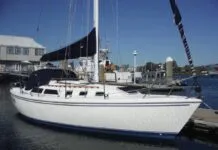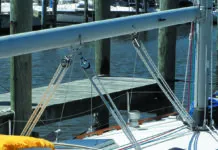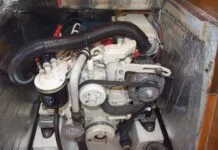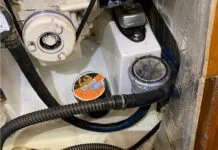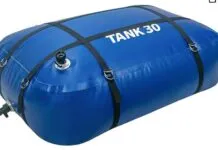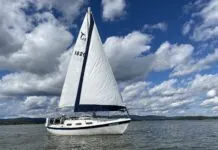Photos by Drew Frye
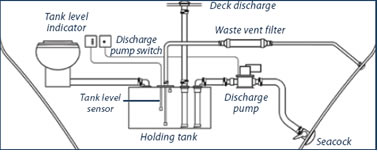
The effectiveness of activated carbon used in holding tank vents (PS recently tested three brands) comes both from surface activity (a result of activation by partial combustion of coal or woody products) and the vast pore structure formed during this partial combustion. Anything that clogs the pores will dramatically reduce carbon life, potentially ruining it within minutes.
Even fresh water can dramatically reduce the pores effectiveness, though this loss in capacity is temporary and is recovered with drying. But heres the catch: The filter will not dry unless it is removed from the boat and flushed with dry air for many hours.
Salt water is worse, leaving a residue in the pores that is fatal to carbon efficiency. Thus, it is vitally important that the vent filter is installed so that seawater cannot splash into it, even when heeled, and that sewage splash and overflow are directed away.
Be sure to place the vent filter high or provide a high loop between the through-hull and the vent filter to avoid accidental dousing.
Clogs Are Bad News
Clogging a tank vent with sewage-with or without a vent filter-is a serious matter.
The carbon will become plugged and the vacuum formed during pumpout can collapse the tank. Pressure formed while pumping the head can rupture the tank (very rare) or cause eruption of sewage (more common) when the pumpout cap is removed. Ugh.
This also can be avoided with proper installation.
Mount Vent High
Vent filter makers Dometic/SeaLand and Big Orange accept mounting the filters directly on the holding tank, though all manufacturers recommend mounting them as high as possible. Some owners will rely on tank gauges or diligent pumpouts to prevent overflows, but we don’t think this is enough. A more fail-safe installation is required. Certainly, the holding tank can be pumped before it becomes too full-and this is good practice since overflowed or over-filled tanks can plug a free vent through simple buildup-but just one mistake during the life of a carbon filter will ruin the filter and place the tank at risk.
Newer tanks are often fitted with vacuum break valves, but older tanks are not. The Big Orange filter is equipped with an integral vacuum relief valve, but other filters are not. In any case, vacuum relief valves do not address over-pressure. (See Marine Holding Tanks Go Head-to-Head in the February 2012 issue.) The over-pressure problem is less prevalent because the volume pumped during a flush is small and pressure has more time to bleed off. That said, pumpout-station geysers are not unheard of.
Photos by Drew Frye
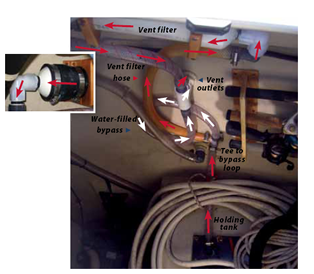
DIY Pressure Control
Were testing a more robust installation, including a bypass through a water-filled trap. Excess sewage can go through this low-mounted bypass, while holding tank gases are held back. (This same mechanism is found under every household sink and toilet: The P-shaped trap directs sewer gas away from the room and up through a vent in the roof.) As the vent comes out of the holding tank, provide a T, where the gases can either continue up a minimum of 18 inches above the through-hull fitting to the vent filter inlet, or can go through a loop of hose (filled with water). The loop outlet is connected to a second T that is mounted on the through-hull fitting, where the vent filter outlet also exits. The gases go through the filter and only splashed water or sewage can go through the loop.
The filter is mounted high, and gravity keeps it dry. Though in principle, the water could evaporate from the loop, this has proven to take over a year in practice. Antifreeze can be substituted where this is a concern.
Practical Sailor even tested the system with an intentional overflow-no problem. Note: The test boat was factory-fitted with 3/4-inch ID hose, one size up from the industry-standard 5/8-inch; we believe 5/8-inch hose is too small to protect the filter in the case of a full tank overflow, unless the 18-inch elevation is increased. We used clear vinyl tubing so that we could watch the behavior of the system; sanitation hose should be used on the tank side of the system, though soft vinyl hose can be used between the vent filter and the through hull.
Many sailors back flush the vent line at each pumpout to prevent vent plugging. If this is your practice, install a valve at the outside end of the vent filter to protect it from water intrusion during back flushing of the vent line. This valve is only closed during vent back flushing.
Mounting the vent filter in a high location, well above the heeled waterline and the holding tank can be a problem on sailboats, although its usually easy enough on most multi-hulls and power boats. If proper installation is impossible, youre likely to have trouble with plugged filters and ruined carbon, so reconsider whether a vent filter is the right solution for your boat.





